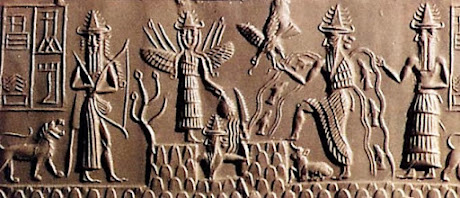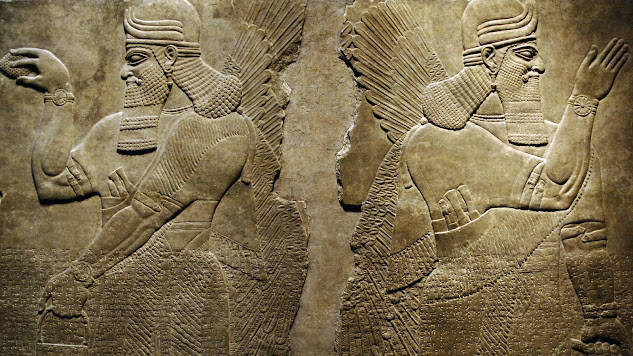Mesopotamia: "Cradle of Civilization - A Journey Through Time"
Welcome to a captivating journey through time to one of the most intriguing and influential cradles of civilization, Mesopotamia. Imagine a land nestled between two mighty rivers, the Tigris and the Euphrates, where ancient societies thrived, created, and paved the way for human progress. Join us as we unravel the mysteries of this remarkable region and explore its profound impact on our world today.
Chapter 1: The Birthplace of Civilization
Mesopotamia, a term that translates to "between the rivers" in Greek, was aptly named due to its unique geographical location. This region, encompassing modern-day Iraq, southeastern Turkey, parts of Iran, and Syria, is where human civilization as we know it first emerged. The cradle of civilization, indeed!
.svg.png) |
| Mesopotamia |
Chapter 2: The Sumerians - Architects of the Past
Our journey begins with the Sumerians, one of the earliest and most influential peoples in Mesopotamia. Around 3500 BCE, they laid the foundations of organized societies by establishing city-states such as Uruk and Ur. Their contributions to human progress were astounding. They developed the world's first writing system, cuneiform, which was etched onto clay tablets. This script wasn't just for record-keeping; it evolved into a medium for literature, poetry, and epic tales, including the famed Epic of Gilgamesh.
 |
| Sumerians Cuneiform |
Chapter 3: Laws and Empires
But Mesopotamia wasn't just about writing; it was a cradle of innovation. The region saw the rise of powerful empires like the Akkadians, led by the legendary Sargon the Great. Around 2334 BCE, Sargon established one of the first empires in history, stretching his dominion across Mesopotamia. These empires brought about legal systems like Hammurabi's Code, a remarkable early legal code that laid the groundwork for justice systems worldwide. Hammurabi's Code was known for its principle of "an eye for an eye," emphasizing fairness and equity.
 |
| Sargon the Akkad |
Chapter 4: Assyrians and Neo-Babylonians - Builders and Conquerors
As time marched on, the Assyrians rose to prominence with their formidable military might. Their ruthless tactics and iron-fisted rule were infamous, yet they also contributed to the advancement of science, culture, and architecture. Meanwhile, the Neo-Babylonians, under Nebuchadnezzar II, embarked on a quest to restore the grandeur of the ancient city of Babylon. Their achievements in urban planning and the reconstruction of Babylon left an indelible mark on history.
 |
| Nebuchadnezzar II |
Chapter 5: Inventions and Innovations
Mesopotamians were pioneers in various fields. They invented the wheel, a simple yet revolutionary invention that transformed transportation and industry. The plow and the sailboat were other marvels that propelled agriculture and trade to new heights. In mathematics, they developed the sexagesimal system, which we still use for measuring time and angles. These innovations underscore their ingenuity and the lasting impact of their contributions on our modern world.
 |
| Mesopotamian Invention |
Chapter 6: Religion and Mythology
Religion played a central role in Mesopotamian life. Their pantheon of gods and goddesses, including Anu, Enlil, and Inanna (Ishtar), shaped their spiritual beliefs. Temples called ziggurats were built as towering tributes to these deities. The rich tapestry of Mesopotamian myths and epic stories, like the Epic of Gilgamesh, not only entertained but also conveyed profound moral lessons.
 |
| Mesopotamian Gods |
Chapter 7: Decline and Legacy
As with all great civilizations, Mesopotamia faced periods of decline. The region fell under the sway of the Persian Empire, led by Cyrus the Great, in the 6th century BCE. However, its legacy endures. Mesopotamia's contributions to writing, mathematics, governance, and legal systems continue to shape our world. The legal codes, especially Hammurabi's, have left an indelible mark on the development of laws in societies across the globe. The cultural and religious traditions of the region continue to influence the Middle East and beyond.
 |
| Cyrus the Great |
Conclusion:
As we conclude our journey through the annals of Mesopotamia, we stand in awe of this cradle of civilization. It is a place where human ingenuity, artistry, and intellect converge to shape the world we inhabit today. Mesopotamia's legacy is a testament to the enduring power of ancient civilizations and their profound influence on the tapestry of human history. We hope you enjoyed this expedition through time, discovering the wonders of Mesopotamia, and that you carry its lessons with you as we continue to explore the marvels of our past.
Publisher: Ben Sebastian K.S.M.
Source: Chat GPT (Open AI)

Comments
Post a Comment